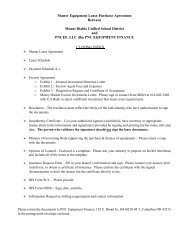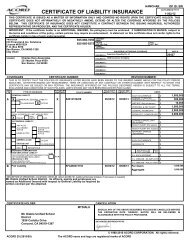Study of the Mount Diablo Unified School District - Mt. Diablo Unified ...
Study of the Mount Diablo Unified School District - Mt. Diablo Unified ...
Study of the Mount Diablo Unified School District - Mt. Diablo Unified ...
- No tags were found...
You also want an ePaper? Increase the reach of your titles
YUMPU automatically turns print PDFs into web optimized ePapers that Google loves.
Introduction and Peer <strong>District</strong> ComparisonsEXHIBIT 1‐1MT. DIABLO UNIFIED SCHOOL DISTRICTSUVEY ACTUAL AND TARGET RESPONSE RATESSURVEY GROUPACTUALRESPONSES/POPULATION(N)RESPONSEPERCENTAGETARGETRESPONSES/POPULATION(N)TARGETPERCENTAGECentral Office Administrator 24/27 88.9% 25/27 92.6%Principal/Assistant Principal 66/108 61.1% 84/108 77.8%Special Education Teacher 116/218 53.2% 139/218 63.8%General Education Teacher 402/2,145 18.7% 326/2145 15.2%Support Staff 54/91 59.3% 74/91 81.3%Source: Created by MGT <strong>of</strong> America, Inc., 2010.• Onsite Data Collection. This instrument collected specific data and information toexpand on <strong>the</strong> information gleaned from our earlier review <strong>of</strong> special educationprogram documentation. It includes data and information about <strong>the</strong> policies andprocedures, early intervening services, school and classroom observations, IEP and504 Plans, service delivery options, evaluation and placement procedures, studentdiscipline, and <strong>the</strong> evaluations conducted by <strong>the</strong> school or program. Fiscal analysesare an extensive part <strong>of</strong> this study.• Onsite Interview Form. This form was used to conduct personal interviews <strong>of</strong> <strong>the</strong>key stakeholders <strong>of</strong> special education services both at <strong>the</strong> district and school levels.This instrument solicited opinions about <strong>the</strong> program models, roles <strong>of</strong> stakeholders,and barriers to successful maximization <strong>of</strong> educational goals and objectives <strong>of</strong> <strong>the</strong>sestudents.• Financial Utilization Pr<strong>of</strong>ile. A financial utilization pr<strong>of</strong>ile was used to provide onsiteinformation on <strong>the</strong> cost factors that vary among programs with similar titles. In asite‐based system <strong>of</strong> service delivery, costs vary among similar programs dependingon <strong>the</strong> emphasis given to particular forms <strong>of</strong> service delivery (e.g., students withspecific learning disabilities may be served at one school in a pull‐out setting with aspecial education teacher; however, in <strong>the</strong> next school <strong>the</strong> same type <strong>of</strong> student mayreceive less pull‐out support and benefit instead from <strong>the</strong> aide assigned to <strong>the</strong>general education classroom. While both options may be programmatically sound,<strong>the</strong>y represent different cost factors in <strong>the</strong> analysis). The financial utilization pr<strong>of</strong>ileassisted <strong>the</strong> review team in determining <strong>the</strong> qualitative difference among programswhen costs are compared.To identify cost improvements for special education programs whose cost factors vary as aresult <strong>of</strong> a wide range <strong>of</strong> indirect cost factors, <strong>the</strong> MGT review team:• Conducted interviews <strong>of</strong> stakeholders at a sample <strong>of</strong> sites.MGT <strong>of</strong> America, Inc. Page 1‐3















